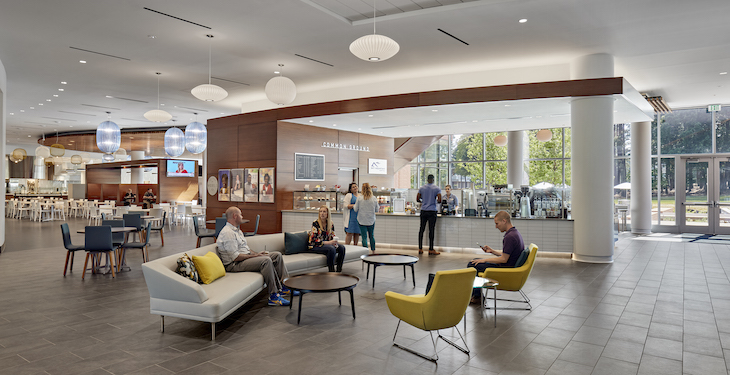RTI International’s new North Carolina headquarters inspire collaboration.
RTI International tapped Duda|Paine Architects to design its headquarters on its Research Triangle Park campus that would reflect its mission of using science for the global good. The building serves as a catalyst for collaboration among diverse research areas; it also affords space to showcase RTI’s accomplishments.

When was the project completed?
2018
How much space?
190,000 GSF
Was this new or renovated space?
New
SF per person?
283 PSF
How many employees?
670
What is average daily population?
817 (estimate)
Is there a mobile work or work from home policy? If so, what percent of employees are remote workers?
Yes, however building designed with 1-to-1 ratio, providing every employee an assigned seat. Remote working is supported by benching stations and focus rooms on each floor to allow flexibility now and for future growth.
Describe workspace types.
In addition to Level-2 open collaboration spaces and clustered lounges in the Collaboration Station, workspace types include:
- Open workstations
- Bench workstations
- Single-occupancy offices
- C-Suite offices (Level 2)
- Board room (Level 2)
- Huddle rooms (2-3-person)
- Single-person Focus rooms, for visiting employees to work on laptops or take a phone/conference call (5)
- Innovation Hub with variety of flexible seating in open plan (Level 2)
- Innovation rooms in various configurations to suit needs of specific group task (Level 2)
- Small, medium and large conference rooms (at least one of each/every office level)
- Virtual Reality lab (Level 2)
- Treadmill “walk/talk” meeting room (Level 2)
- Variety of seating in building nooks provide easily accessed/flexible space (every level)
- Dining room areas and coffee bars provide opportunities for more relaxed work sessions. (Levels 1 & 2)
- Remote work spaces for others around RTI’s campus via benching, collaborative spaces and dining areas (levels 1 & 2 and office)

What kind of meeting spaces are provided?
- Large, flexible multipurpose room for 300, which can be sub divided into two or three spaces to suit gathering needs, with adjacent outdoor terrace
- Small (6-8-person), medium (10-12-person with informal seating for video conferencing or traditional seating) and large meeting/conference rooms (20-person) to accommodate a variety of different meeting sizes and types
- 2-3-person Huddle rooms
- Open Collaboration Station zone with variety of different collaborative seating configurations intended to provide diverse teams within building options for informal team meetings; and provide visiting employees a variety of settings to work ‘remotely’ on laptops from other campus buildings.
- Common Ground Coffee Bar on Level 1 offers free “RTI Blend” coffee to staff members and their guests as well as light fare and snacks throughout the day
- Level-2 Coffee Bar in Collaboration Station also has free coffee to encourage employees from Levels 3-6 to mingle with employees from other departments
- Innovation Hub: RTI’s vision was to allow groups across campus to potentially come together for days or weeks as needed with the goal of incubating ideas as a team. This space on Level 2 has open ceilings, a more industrial, high-tech feel that reflects tech-firm start-up culture to encourage brainstorming, ideation, innovation.
- Incubator rooms around Innovation Hub utilize a variety of configurations to suit diverse group dynamics and collaboration needs (eight for from 6 to 8 users).
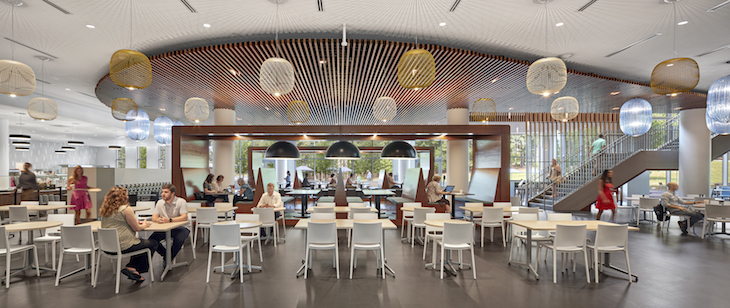
What other kind of support space or amenity spaces are provided?
RTI emphasized type and configuration of amenity spaces to increase interaction and collaboration:
- Seating for the café/coffee bars includes bar height counters & stools for laptop working as well as lounge sofa & chairs for informal socializing and café tables for drinking coffee/socializing/informal meetings.
- Dining seating includes:
- Bar-height 9-person tables for laptops/informal meetings.
- Three centralized communal harvest tables encourage communal dining and socializing between offices/buildings; names of all RTI’s global locations engraved into tabletops.
- Custom designed/crafted booths for more intimate dining experience and to encourage communal dining and socializing. Booths create more intimate setting, and with harvest tables, create centralized zone for communal dining to meet one of RTI’s main missions of bringing campus population together.
- Café tables broken into two zones (East and West of communal dining) creating more acoustic and visual privacy, rather than large sea of open tables
- Upholstered banquette seating at bottom of dining creates visual and acoustic barrier between servery, and alternate setting for dining.
Has the project achieved any special certifications?
Targeting LEED Silver Certification
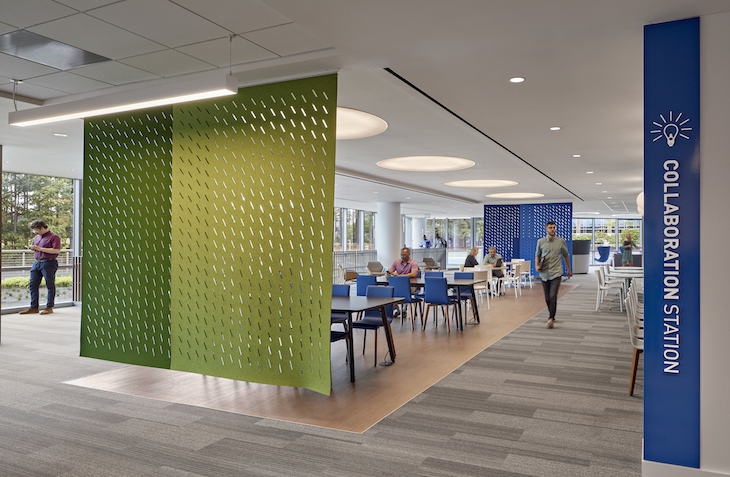
What is the project’s location and proximity to public transportation and/or other amenities?
Located in RTI’s existing suburban campus in North Carolina’s Research Triangle Park, parking deck configuration encourages carpooling and has several electric vehicle charging stations; the Horizon building serves as core campus meeting place with multiple entrances leading to pedestrian walkways to other buildings.
Was the C-suite involved in the project planning and design process? If so, how?
Yes, executive assistants played important role in meetings during programming representing all executives. They provided specific direction on needs and wants of the executive leadership team in terms of their offices and executive suite.
In addition, C-suite also provided a tour of their existing suites, and CEO and COO were given executive-level presentations at Schematic Design and Design Development phases. They participated in selecting furniture for project, testing different chairs at furniture vendor as well as helping make other furniture decisions.
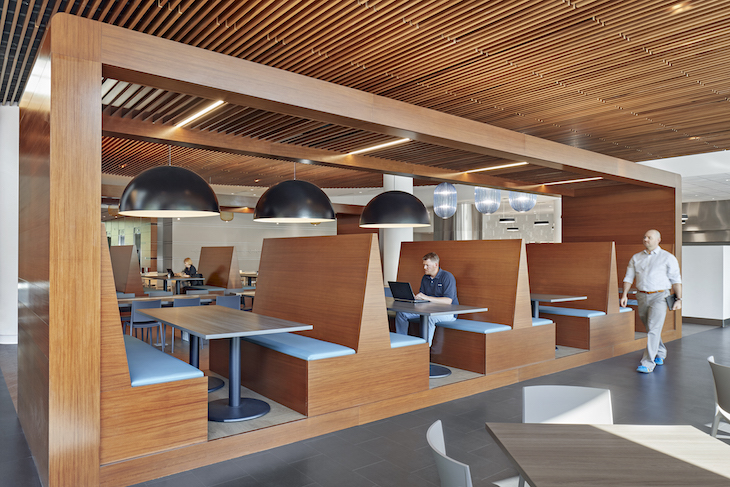
Were any change management initiatives employed?
Yes. Furniture was utilized to inform and drive change management. The types of work station and open collaborative spaces employees received—and types of furniture—were part of the change management process. Before this new headquarters, nearly all RTI employees typically had offices—roughly 90 percent. This building has offices for about 60 percent. Thus, it represents a huge cultural shift for RTI and their people in terms of day-to-day work life. The furniture vendor signed a three-year contract with RTI and helped put a change management process together.
Please describe any program requirements that were unique or required any special research or design requirements.
Virtual reality lab on level two was unique and a newer program element for design professionals. Also, aspects of the multipurpose room, which is for 300 people, required research into flexibility requirements and solutions.
The Impact Display required additional research. In collaboration with the communications department and exhibit design specialist, a large public display now showcases the impact of the institute’s work around the world.
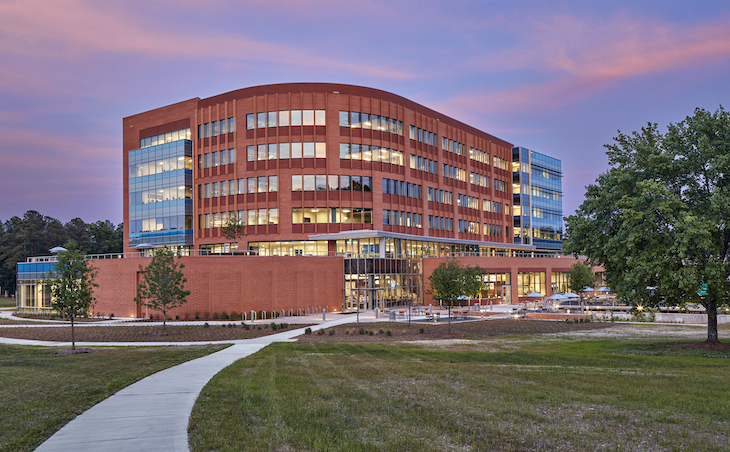
Was there any emphasis or requirements on programming for health and wellbeing initiatives for employees?
Issues of health and wellness were always at forefront of RTI’s vision. On the north side of the second-level Collaboration Station is a very large outdoor terrace, with an extended area beside the boardroom to allow RTI’s people to take a coffee, eat lunch outside, or work outside. Also, groups using board’s meeting room or gathering in open Collaboration Station can spill onto the terrace or have exterior meeting space.
The treadmill room allows staff to work on laptop and walk or allows two people to walk and meet. The dining area and coffee bar food selection includes options to ensure healthy eating, fulfilling one of RTI’s initiatives. While WELL building certification was not pursued, many wellness strategies were incorporated. Also, a planted green roof along the west side provides views of greenery as employees walk into building from garage.
Were there any special or unusual construction materials or techniques employed in the project?
Transitioning between brick and aluminum curtainwall detailing required great care as new energy standards proved challenging. The brick layout and execution was paramount to building aesthetic as stacked bond Norman brick requires a great amount of planning and precision.
For specific examples, please describe the product, how it was used, and if it solved any specific problem.
Extruded aluminum shading devices on building’s west side needed to perfectly align with the glazing within the brick spacing. With the curtain wall manufacturer, an offset bracket was developed to account for brick spacing between different levels and allowed for fins to remain straight and continuous.
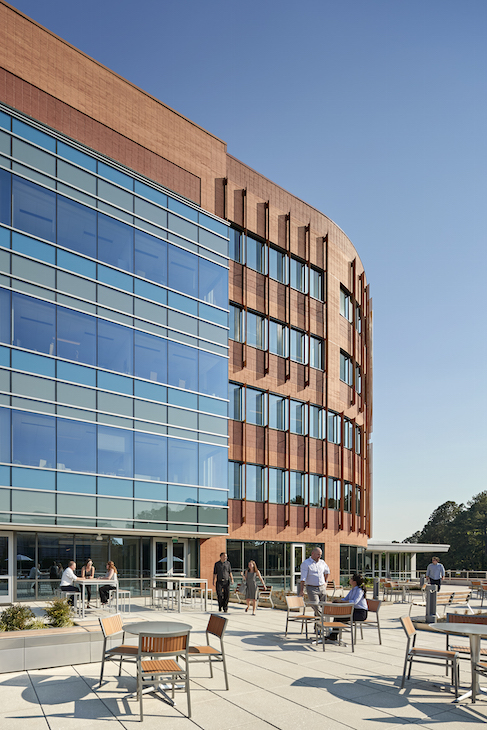
What products or service solutions are making the biggest impact in your space?
Most impactful office furniture items:
- Haworth Fern chair – task chair
- Haworth Very chair – meeting room chair
- Workstations & Desks custom designed by PMC with Haworth products
Dining/Café:
- Café seating booths to spec
- Allermuir Tonina (typical dining chair)
- Haworth Jive (typical dining table)
Lounge/Flex Space:
- Orangebox Away from the Desk (collaborative seating)
- Haworth Intuity (large working table)
- Haworth Very (task chair)
What kind of branding elements were incorporated into the design?
Collaboration space signage, retail store with branded merchandize, café & dining wall elements for three venues, IT service bar signage.
What is the most unique feature of the new space?
RTI’s purpose for Level 2’s design was to create a campus Collaboration Station where people from across RTI’s campus and employees visiting from global locations could meet and work ‘remotely’ on laptops and socialize. The intention is to encourage collaboration across all campus departments and within company, and to break down silos that exist in other campus buildings. The Collaboration Station reflects tech firm culture influencing workplace design across all industries over past several years. RTI’s aim is to create a shift in the way their employees interact across Departments and all offices, to ultimately be more collaborative.
Are there any furnishings or spaces specifically included to promote wellness/wellbeing?
Outdoor spaces adjacent to collaboration areas and dining areas allow employees to be outside during work day. A bio-retention environmental feature provides every day relaxation space. 2nd-floor employee entrance from parking deck circulates by a landscaped green roof to promote wellness when arriving and leaving the work day.
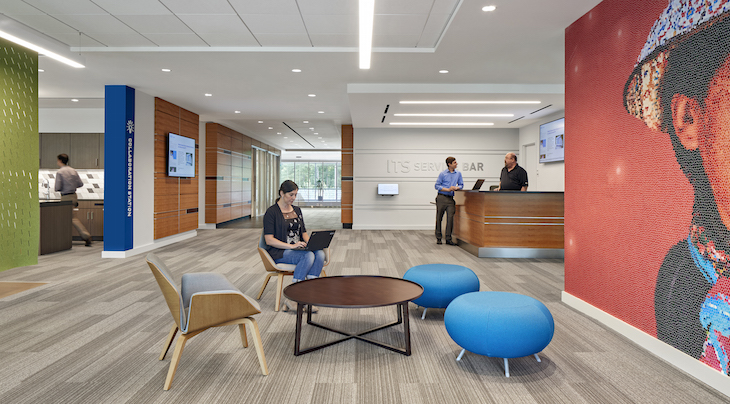
What kind of technology products were used?
The latest AV connects RTI employees from all corners of globe. Office levels use different shades of brand standard blue and green to assist wayfinding per floor and for those with impaired vision.
If the company relocated to new space, what was the most difficult aspect of the change for the employees?
The company went from 90-100 percent enclosed offices to 60 percent offices, many with transparent walls; thus, almost half of the population moved from an office into a workstation.
The design team created workstation neighborhoods, so for any given workstation there are only 10 other workstations around, keeping interiors free of large floorplates of workstations.
How did the company communicate about the changes and moves?
A robust internal communications and social media plan included a steady cadence of articles, posts and video communication that highlighted the building’s features and tracked the construction progress from day one. These communications kept the campus community and RTI staff at-large informed. Pre-move-in tours were held with staff to acquaint them with their new workspaces, and entire move-in crews assisted in employees getting settled. IT experts were on hand to assist staff as they geared up to begin work in their new work spaces.

If so, what were the most surprising or illuminating or hoped-for results?
Almost immediate adoption of open working environment and collaborate spaces, after occupying single offices, was most surprising and rewarding result.
If change management program was in place, what were the most successful strategies?
The collaboration concept was a change for RTI as it sought to “un-silo” departments and promote cross-pollination of ideas. The Executive Leadership Team was moved from top level in previous building to share 2nd level collaboration floor of Project Horizon to promote vertical and horizontal corporate collaboration.

